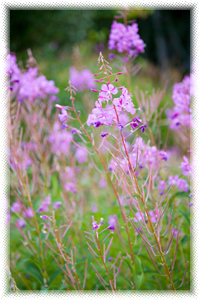Fireweed Epilobium angustifolium

A patch of wild fireweed flowers
- Common Names
- Fireweed , Great or Spiked Willow-herb
- Botanical Name
- Epilobium angustifolium
- Family
- ONAGRACEAE
Medicinal Uses & Benefits of Fireweed
Side Effects | Plant & Garden|
How to Use: Fireweed
Preparation Methods & Dosage :
Plant Description
- Epilobium angustifolium syn. (Chamaenerion angustifolium)
- Flowers:Magenta or pink, sometimes pale, or rarely white, more or less than 1 in. across, in an elongated, terminal, spike-like raceme.
- Calyx: tubular, narrow, in 4 segments; 4 rounded, spreading petals; 8 stamens; 1 pistil, hairy at base; the stigma 4-lobed. Stem: 2 to 8 ft. high, simple, smooth, leafy. Leaves: Narrow, tapering, willow-like, 2 to 6 in. long.
- Fruit: A slender, curved, violet-tinted capsule, from 2 to 3 in. long, containing numerous seeds attached to tufts of fluffy, white, silky threads.
- Preferred Habitat: Dry soil, fields, roadsides, especially in burnt-over districts.
- Flowering Season: June—September.
- Distribution: From Atlantic to Pacific, with few interruptions; British Possessions and United States southward to the Carolinas and Arizona. Also Europe and Asia.
Spikes of these beautiful brilliant flowers towering upward above dry soil, particularly where the woodsman's axe and forest fires have devastated the landscape, illustrate Nature's abhorrence of ugliness. Other kindly plants have earned the name of fireweed, but none so quickly beautifies the blackened clearings of the pioneer, nor blossoms over the charred trail in the wake of the locomotive. Whole mountainsides in Alaska are dyed crimson with it. Beginning at the bottom of the long spike, the flowers open in slow succession upward throughout the summer, leaving behind the attractive seed-vessels, which, splitting lengthwise in September, send adrift white silky tufts attached to seeds that will one day cover far distant wastes with beauty. Almost perfect rosettes, made by the young plants, are met with on one's winter walks.
2- wikipedia.org/wiki/Epilobium_angustifolium
- Netje Blanchan. Wild Flowers worth Knowing (1917)










